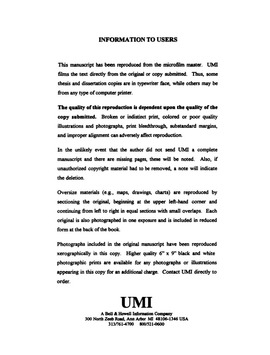| dc.contributor.advisor | Paul, Stephen J., | en_US |
| dc.contributor.author | Graessle, Ramona Kime. | en_US |
| dc.date.accessioned | 2013-08-16T12:30:17Z | |
| dc.date.available | 2013-08-16T12:30:17Z | |
| dc.date.issued | 1998 | en_US |
| dc.identifier.uri | https://hdl.handle.net/11244/5700 | |
| dc.description.abstract | Most schools used enrollment numbers as the primary means to determine success in programming. Other informal methods, such as discussions with faculty and participants, also were used by over three-fourths of the schools. Informal methods also comprised the primary means by which schools determined adults' music interests. | en_US |
| dc.description.abstract | Private lessons were considered the most successful, primarily because of quality of faculty, flexibility in scheduling, and the ability to meet individual needs. Chamber ensembles were mentioned most frequently as being less successful, particularly because of the difficulty in scheduling and the difficulty in matching students' skill levels. | en_US |
| dc.description.abstract | Enrollment information indicated that adults comprised 15.7% of the students at National Guild schools. The percentage of adult music students at Guild schools ranged from eight schools with no adult music students to five schools with over 50% adult students. | en_US |
| dc.description.abstract | The purpose of this study was to determine the status of adult music programming in member schools of the National Guild of Community Schools of the Arts. Questionnaires were sent to administrators of the 208 member schools of the National Guild that offer music instruction. The questionnaire elicited information regarding music enrollment numbers, specific music offerings available to adults, music activities considered most and least successful, and methods by which schools make decisions regarding music programming for adults. The return rate was 63.9%. | en_US |
| dc.description.abstract | The people most often making suggestions for new adult activities were the students, faculty, and administrators. School administrators and faculty made most of the final decisions regarding adult music programming. Decisions regarding potential programs were most affected by the music interests of clientele and the availability of both faculty and facilities. | en_US |
| dc.description.abstract | The most frequently offered music activity was the private lesson. Music theory and chamber ensembles were offered at over half of the schools, and large ensembles and group instruction were offered at many schools as well. Performances were also given at most schools, including three-quarters of the schools that gave performances at off-site locations, most commonly at senior citizen centers, nursing homes and churches. | en_US |
| dc.format.extent | viii, 146 leaves ; | en_US |
| dc.subject | Music as recreation. | en_US |
| dc.subject | National Guild of Community Schools of the Arts. | en_US |
| dc.subject | Music Social aspects | en_US |
| dc.subject | Music. | en_US |
| dc.subject | Education, Music. | en_US |
| dc.subject | Adult education United States. | en_US |
| dc.subject | Music Instruction and study United States. | en_US |
| dc.title | Adult music programming in member schools of the National Guild of Community Schools of the Arts. | en_US |
| dc.type | Thesis | en_US |
| dc.thesis.degree | Ph.D. | en_US |
| dc.thesis.degreeDiscipline | School of Music | en_US |
| dc.note | Source: Dissertation Abstracts International, Volume: 59-09, Section: A, page: 3387. | en_US |
| dc.note | Adviser: Stephen J. Paul. | en_US |
| ou.identifier | (UMI)AAI9905616 | en_US |
| ou.group | Weitzenhoffer Family College of Fine Arts::School of Music | |
